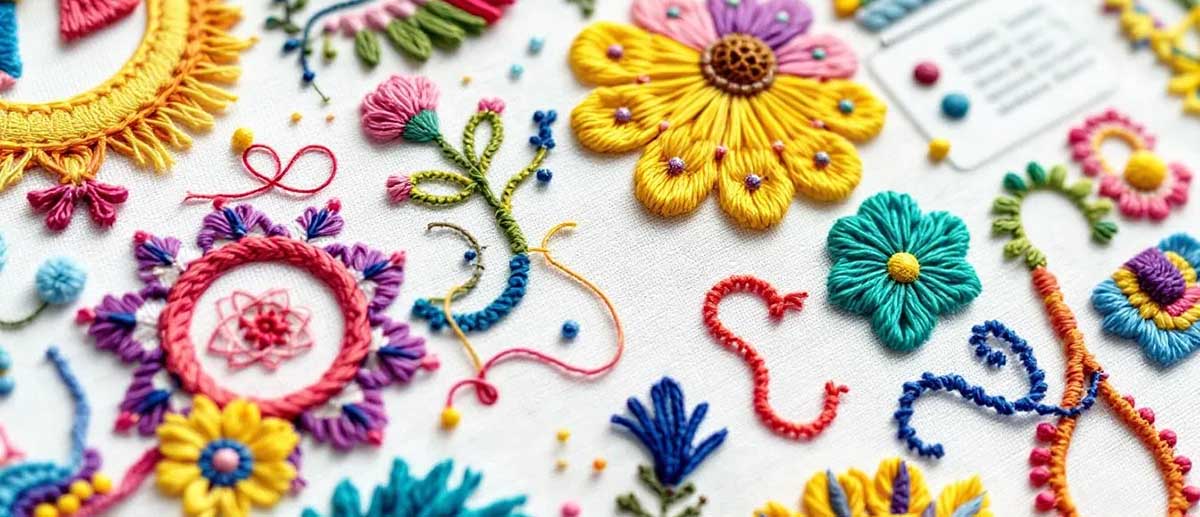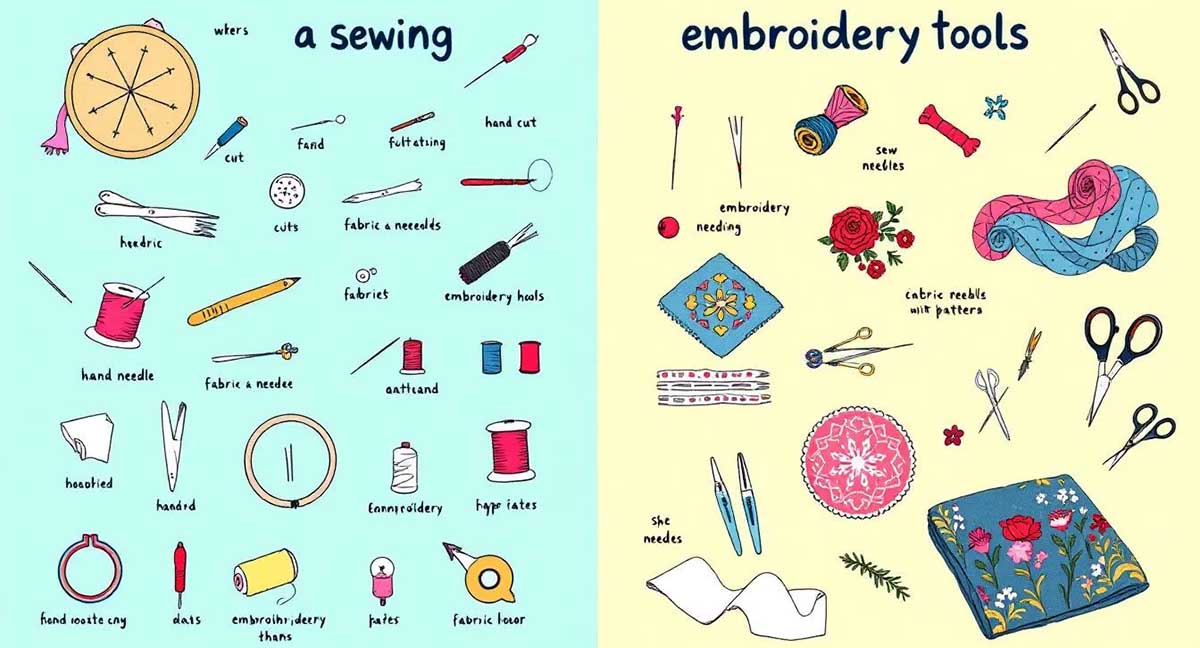Sewing vs Embroidery: Key Differences and Essential Tips

Wondering what sets sewing and embroidery apart? Sewing is about making functional items like clothes by joining fabric pieces. Embroidery, on the other hand, adds decorative designs to fabric. In this article, we’ll dive into the key differences between sewing vs embroidery and provide essential tips for both.
Key Takeaways
-
Sewing focuses on creating functional items by joining fabrics, while embroidery enhances fabric with decorative designs.
-
The essential tools for sewing include sewing machines and sharp scissors, while embroidery uses hoops and decorative threads for embellishment.
-
Both crafts cater to different creative needs: sewing for practicality and embroidery for artistic expression.
Understanding the Basics of Sewing and Embroidery
Sewing and embroidery, although both involving a needle and thread, serve distinct purposes. Sewing focuses on joining pieces of fabric together to create functional items like clothing and home decor, while embroidery brings life to fabrics with intricate designs and colorful threads, enhancing their aesthetic appeal.
What Is Sewing?
Sewing involves using a needle and thread to join pieces of fabric. It is considered an art form. This craft primarily focuses on creating functional items such as clothes, bags, and quilts. Think of sewing as the foundation of garment construction; it’s about making the seams, hems, and structures that hold fabric items together. Common fabrics used in sewing include cotton and denim, chosen for their durability and comfort. The pieces are often sewn together with precision to ensure quality.
The practical applications of sewing are vast. From making clothes and accessories to crafting home items like curtains and cushion covers, sewing allows for a wide range of creative and functional projects. Factors such as durability and comfort guide the choices of fabric and thread, ensuring the creations are not only beautiful but also practical.
What Is Embroidery?
Embroidery is the art of decorating fabric with needle and thread, transforming simple pieces of fabric into intricate works of art. This craft focuses on creating visually appealing designs through the use of decorative stitches and colorful threads. Unlike sewing, embroidering doesn’t join pieces of fabric together but rather embellishes the fabric itself, adding a touch of elegance and personalization.
The beauty of embroidery lies in the intricate designs and the vibrant colors that can be achieved with embroidery threads. From simple patterns to complex images, embroidery enhances the aesthetic appeal of fabric, making it a popular choice for decorative purposes, decorating everything from clothing to home decor items.
Whether it’s through hand embroidery or machine embroidery, this craft allows for endless creative possibilities.
Tools and Materials for Sewing and Embroidery
The tools and materials needed for sewing and embroidery differ significantly, each requiring specific items to achieve the best results. Understanding these essentials is crucial for anyone looking to dive into either craft.
Sewing Essentials
Essential tools for sewing include sharp scissors, a sewing machine, and a variety of needles and specialty threads suitable for different fabrics. Sewing machines are central to modern sewing, offering precision and efficiency that hand sewing alone cannot match. Sewing thread and threads from MH, available in polyester, cotton, and rayon, are designed for durability and strength, making them ideal for garment stitching, upholstery, and even industrial use.
Measuring tools like rulers and tailor’s chalk ensure accuracy in cutting and assembling fabric, while sewing threads engineered for durability ensure that your creations stand the test of time. Whether you’re sewing a simple pillowcase or a complex garment, having the right tool is essential for success.
Embroidery Essentials
Embroidery requires certain essential tools. These include:
-
Embroidery hoop: keep the fabric taut, making it easier to create precise stitches.
-
Embroidery needles.
-
Embroidery floss: available in a myriad of colors, primarily used for decorative embellishments, adding vibrancy and detail to your projects.
Aida cloth is a commonly used fabric for embroidery projects due to its easy-to-count squares, making it perfect for beginners and experienced embroiderers alike. MH’s embroidery thread focuses on color brilliance and smoothness, enhancing the decorative stitching and logo embroidery on your other fabric items.
Techniques and Stitching Methods
Both sewing and embroidery utilize various stitching techniques that contribute to the creation and decoration of fabric items. These technique not only serve functional purposes but also add different textures and patterns that enhance the visual appeal of the final product.
Common Sewing Stitches
Basic sewing stitches include the straight stitch, which is fundamental in sewing and frequently used for seams. The running stitch, one of the simplest stitches, is ideal for beginners and perfect for practice. Straight stitching is an essential skill for any sewer.
Another essential stitch is the backstitch, known for its strength and commonly used for seams that will be turned inside out, providing additional durability. These basic stitches form the backbone of garment construction, ensuring that pieces of fabric are securely joined together.
Popular Embroidery Stitches
Popular embroidery stitches include the satin stitch, which is primarily employed to fill shapes in embroidery designs, creating a smooth and shiny surface. French knots are used in embroidery to create textured points on fabric, often as small decorative elements.
These stitches allow for intricate designs and add depth to stitched embroidered items, making them more visually appealing.
Practical Applications and Creative Expressions

Sewing and embroidery cater to different creative needs and practical applications. Sewing is often used to solve daily needs by providing functional items, whereas embroidery allows for artistic expression through decorative embellishments.
Both crafts offer unique avenues for creativity and can be tailored to suit various techniques for different purposes and goals.
Functional Uses of Sewing
Sewing enables the creation of practical items like bags, which serve both functional and aesthetic purposes. Personalized items such as tote bags and clothing alterations can be designed through sewing, offering a sense of satisfaction from creating something unique and functional. Home decor projects such as cushion covers can be easily crafted, adding a personal touch to interior design.
Zigzag stitches, which provide elasticity, are commonly used on knit and stretch fabrics, showcasing the versatility of sewing techniques. For those interested in practical applications and garment creation, sewing offers a fulfilling and valuable skillset.
Artistic Embellishments with Embroidery
Embroidery has evolved from practical needs to an art form with significant cultural and social implications. Its uses and characteristics include:
-
Storytelling through intricate designs, adding depth and meaning to the fabric
-
Allowing for artistic touches and colorful patterns
-
Enhancing the aesthetic appeal of fabric items
Decorative stitches in embroidery create patterns and images on fabric, transforming simple items into personalized works of art. Whether adding detail to clothing, decor, or gifts, cross stitch embroidery brings a unique blend of creativity and craftsmanship to any project.
Skill Development and Learning Curve
Learning sewing and embroidery can be both challenging and rewarding. Online platforms provide access to tutorials and guides, enabling beginners to improve their skills at their own pace. Some sewing machines come with built-in embroidery functions, allowing for seamless design transitions and facilitating a smoother learning curve.
Starting with Sewing
Starting with simple projects like cushion covers or tote bags helps build confidence and enhance sewing skills for beginners. Essential tools like sewing machines and measuring tapes are crucial for learning sewing techniques and ensuring accurate measurements. These beginner projects help novices master the basics and prepare for more complex creations.
Beginner sewing projects can include items like simple bags or pillowcases, which are manageable and offer a sense of accomplishment upon completion. Practicing these basic techniques is essential for gaining proficiency and developing a versatile skill set in sewing.
Beginning Embroidery
Choosing easy patterns is crucial for beginners to develop their embroidery skills effectively. Starting with basic patterns helps new embroiderers become familiar with essential stitching techniques, such as the backstitch and chain stitch. These simple projects allow beginners to practice and perfect their stitches, building a strong foundation for more complex designs.
Using simple patterns and practicing stitches like backstitch and chain stitch are effective ways for beginners to develop their embroidery skills. As they gain confidence, they can explore more intricate designs and techniques, expanding their creative possibilities in embroidery.
Modern Innovations in Sewing and Embroidery
Technological advancements in sewing and embroidery have revolutionized these crafts, making them more accessible and exciting. Modern machines and tools offer enhanced capabilities, allowing for greater creativity and efficiency in both sewing and embroidery projects.
Advances in Sewing Machines
Modern sewing machines often feature touch screens for user-friendly operation and enhanced programming capabilities. These machines now have programmable patterns for precision and efficiency, allowing users to create complex designs with ease.
Some contemporary sewing machines are equipped with automatic bobbin changers, enabling seamless thread replacement during operation.
Innovations in Embroidery Machines
Digital embroidery machines provide numerous design options and custom patterns, revolutionizing the way designs are created and applied to fabrics. Advancements such as free motion embroidery and customizable designs offer users more control over their embroidery artistry, enhancing the decorative capabilities of the embroidery machine.
Choosing Between Sewing and Embroidery

Choosing between sewing and embroidery depends on your personal interests and goals. While sewing focuses on creating functional items, embroidery is all about decorative embellishments.
Understanding these key differences can help you decide which craft aligns best with your creative difference in contrast.
Assessing Your Interests
Setting clear objectives for your crafting journey can help determine whether to pursue sewing for its practicality or embroidery for its decorative appeal. Consider your personal interests and future aspirations when deciding between the two crafts.
Whether you prefer the satisfaction of creating functional items or the joy of fine artistic expression, knowing your ideas will guide your choice.
Evaluating Your Goals
Crafting goals can vary widely, from creating a few personal projects to pursuing a professional venture in sewing or embroidery, depending on your skill level. Setting realistic targets can help prevent feelings of overwhelm and promote a more enjoyable crafting experience.
Whether you aim to sew practical items or embroider decorative pieces, aligning your goals with your interests will ensure a fulfilling journey.
Summary
In summary, sewing and embroidery each offer unique ways to express creativity and fulfill practical needs. Sewing focuses on joining fabric to create functional items, while embroidery adds decorative touches to enhance the aesthetic appeal of fabric. With the right tools, techniques, and a clear understanding of your goals, you can embark on a rewarding crafting journey. Whether you choose sewing, embroidery, or both, the possibilities are endless.
Frequently Asked Questions
What is the main difference between sewing and embroidery?
The main difference is that sewing is all about joining fabrics to make functional items, while embroidery is focused on adding decorative designs to enhance the fabric's look.
What essential tools do I need to start sewing?
To kick off your sewing journey, grab a sewing machine, sharp scissors, an assortment of needles, and some good-quality thread. Don't forget measuring tools like rulers and tailor's chalk for those precise cuts!
What are some basic embroidery stitches for beginners?
To kickstart your embroidery journey, you can try the satin stitch for filling shapes and French knots for adding texture. Both are simple and essential for beginners!
How can I choose between sewing and embroidery?
Think about what excites you more: creating functional pieces like clothes and home decor with sewing, or embellishing fabrics with beautiful designs through embroidery. Clarifying your interests and goals will guide your choice.
What modern features are available in sewing and embroidery machines?
Modern sewing and embroidery machines include touch screens, programmable patterns, and automatic bobbin changers, allowing for a more creative and user-friendly experience. With digital design options and customizable patterns, you can really take your projects to the next level!
Contact MH
MH offers sewing threads and embroidery threads. Please contact us for more details or inquiries. We're here to help!


